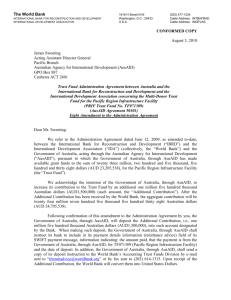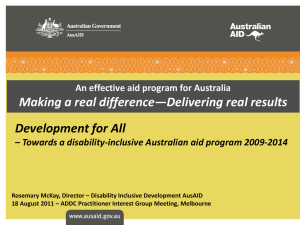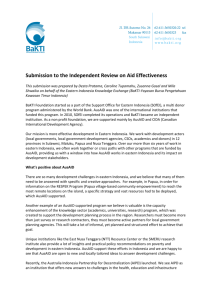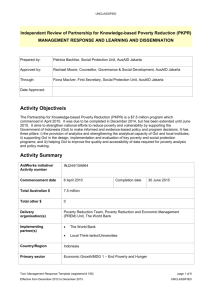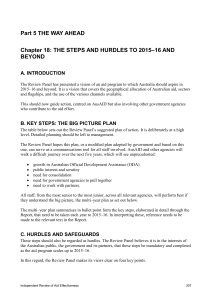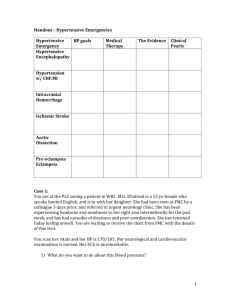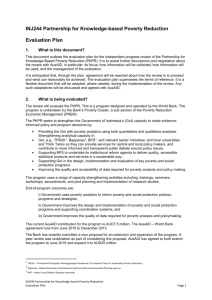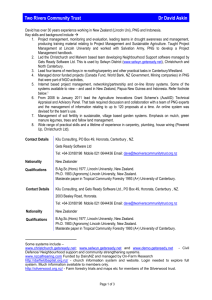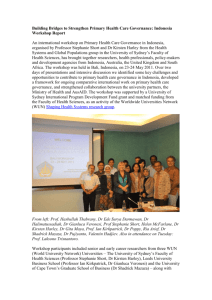INDII FACILITY
advertisement
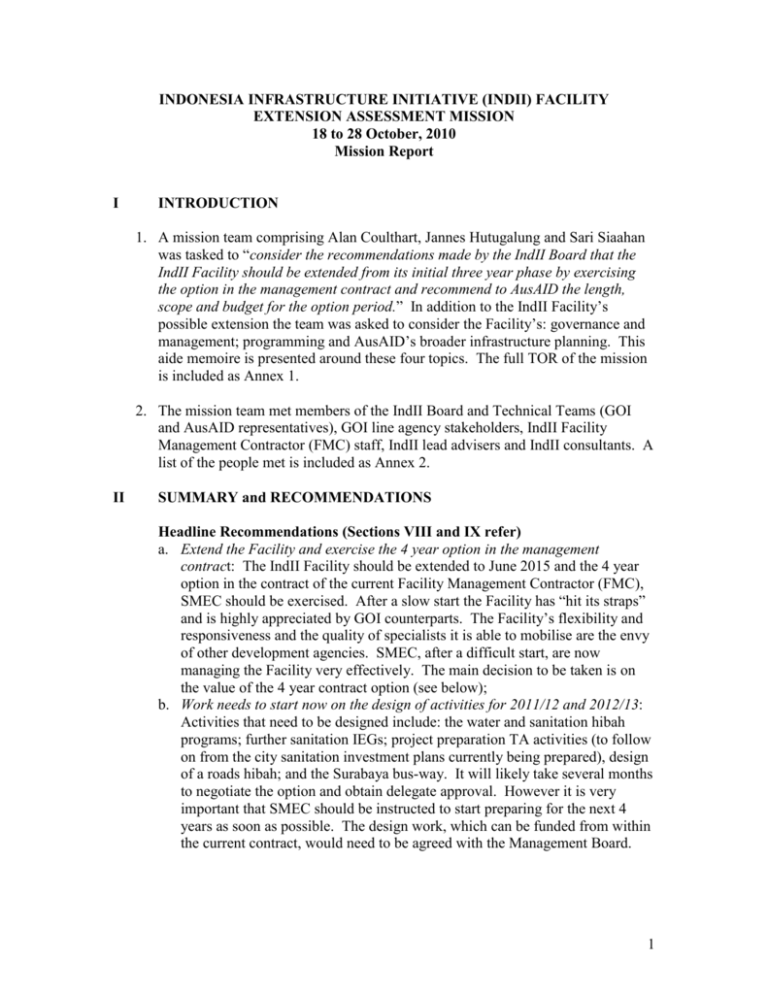
INDONESIA INFRASTRUCTURE INITIATIVE (INDII) FACILITY EXTENSION ASSESSMENT MISSION 18 to 28 October, 2010 Mission Report I INTRODUCTION 1. A mission team comprising Alan Coulthart, Jannes Hutugalung and Sari Siaahan was tasked to “consider the recommendations made by the IndII Board that the IndII Facility should be extended from its initial three year phase by exercising the option in the management contract and recommend to AusAID the length, scope and budget for the option period.” In addition to the IndII Facility’s possible extension the team was asked to consider the Facility’s: governance and management; programming and AusAID’s broader infrastructure planning. This aide memoire is presented around these four topics. The full TOR of the mission is included as Annex 1. 2. The mission team met members of the IndII Board and Technical Teams (GOI and AusAID representatives), GOI line agency stakeholders, IndII Facility Management Contractor (FMC) staff, IndII lead advisers and IndII consultants. A list of the people met is included as Annex 2. II SUMMARY and RECOMMENDATIONS Headline Recommendations (Sections VIII and IX refer) a. Extend the Facility and exercise the 4 year option in the management contract: The IndII Facility should be extended to June 2015 and the 4 year option in the contract of the current Facility Management Contractor (FMC), SMEC should be exercised. After a slow start the Facility has “hit its straps” and is highly appreciated by GOI counterparts. The Facility’s flexibility and responsiveness and the quality of specialists it is able to mobilise are the envy of other development agencies. SMEC, after a difficult start, are now managing the Facility very effectively. The main decision to be taken is on the value of the 4 year contract option (see below); b. Work needs to start now on the design of activities for 2011/12 and 2012/13: Activities that need to be designed include: the water and sanitation hibah programs; further sanitation IEGs; project preparation TA activities (to follow on from the city sanitation investment plans currently being prepared), design of a roads hibah; and the Surabaya bus-way. It will likely take several months to negotiate the option and obtain delegate approval. However it is very important that SMEC should be instructed to start preparing for the next 4 years as soon as possible. The design work, which can be funded from within the current contract, would need to be agreed with the Management Board. 1 Governance and Management (Section IV refers) a. Management Board: the mid-term review of the Impact Assessment Team (IAT) found that the Management Board (MB) was not sufficiently engaged. This remains the case. However, in spite of this the Facility is working well. It is focussed on GOI’s infrastructure priorities and the activities in line ministries and sub-national governments appear to have strong ownership. That said it is important to persevere with the MB to provide assurance that the Facility continues to reflect Government’s infrastructure priorities. Formalising the appointment of GOI members through a “decision letter” issued by the Minister of Bappenas should be explored as a means of improving engagement. Also a senior consultant who is well respected in senior GOI circles should be hired to ensure Board members are kept informed of key issues as proposed at the September 2010 MB meeting. b. Technical Teams: the Technical Teams (TTs) have reportedly functioned better in recent months but there is still room for improvement (it continues to be difficult to ensure sufficient GOI participation). Again formal appointment of GOI TT members by the Bappenas Deputy for Infrastructure is recommended. This may enable incentives to be paid within Government’s system. The role and operating procedures of the TTs should be formally defined. It is also recommended that efforts are made to increase interest by enabling TT members to visit activities under implementation. c. Streamline AusAID’s Reviews and Approvals: AusAID staff reportedly currently issue an average of 6 approvals per week relating to the Facility. These range from FMC expenditure approvals to the approval of activity designs. Consideration should be given to: (i) increasing the delegated authority given to the FMC on contract related expenditure; and (ii) adopting a single step approval process for activity designs (currently the TT approves designs in principle and AusAID subsequently issues unilateral approval to a more detailed design). This would however depend on better engagement by the GOI TT members. Public Diplomacy (Section V refers) a. Best practice: The EAM team consider that the FMC is doing an effective job through its excellent website, quarterly Prakarsa journal, press releases and activity launchings and openings. It represents best practice in AusAID’s infrastructure sector. Recommendations of the recent public diplomacy paper for infrastructure commissioned by the Post should be taken into account. Monitoring and Evaluation (Section VI refers) a. Improvements being implemented: M&E was the other weakness identified by the IAT at the mid-term review. The FMC seems to be putting measures in place to ensure that M&E is an integral part of all new activities and that there is coherence at all steps from design through to implementation. b. Evolving M&E framework: The M&E Framework has been updated as the Facility has evolved, most recently in March 2010 to reflect addition of the WSI. It is compatible with AusAID’s Performance Assessment Frameworks for infrastructure. Given the nature of the Facility it will need to remain a “living document”. It should be updated for Phase 2 to reflect the three 2 current components. Input from the international specialist should also be increased. It probably needs to be fairly intensive in the first year of Phase 2. A specific budget line for activity evaluation should also be established in the imprest account. c. IAT should undertake periodic reviews: Recommendation # 12 of the midterm review that the IAT should periodically review the impact of a large subset of activities e.g. road transport, water and sanitation hibahs should be adopted. An appropriately qualified Indonesian professional should be added to the IAT for this work. d. Presenting results: The presentation of M&E in the FRPDs should be improved with greater use of graphics and pictures. IndII Facility Programming (Section VII refers) a. Budget allocations: At present only $395 million is available for 2011/12 to 2014/15 – this assumes $120 million from EINRIP and $275 million from existing infrastructure budget measures. There is currently no dedicated water and sanitation funding after June 2011. Future budget plans are currently uncertain. b. Future programming: following Amendment 1 to the contract the FMC is managing, or has oversight of funds worth around $85 million. Of this $25 million (for the water and sanitation hibahs) is outside of the Facility imprest account. The FMC consider they could manage much more – up to $125 million/year. Much of this would be funding for physical infrastructure through hibahs, IEGs and co-financing MDB projects (see below for an assessment of the realistic value of the option). c. Maximising the funds over which the Facility has oversight: Given the effectiveness of the Facility, the increasing size of the infrastructure program and the constraints on AusAID’s staff resources it would be desirable to maximise the value of the contract option. The Facility should be increasingly used to manage funds that are outside of the imprest account. This would expand on what has been done in Phase 1 with the water and sanitation hibahs that are funded through a Direct Funding Agreement (DFA) established by Post in the Bank of Indonesia. The Facility imprest account currently supports: (i) policy TA, (ii) project management (project preparation, design and implementation oversight) of Infrastructure Enhancement Grants (IEGs), water and sanitation hibahs and city sanitation plans; and (iii) funding for IEGs. Placing funds for IEGs and part of project management/preparation as well as for the hibahs in DFAs would maximise the overall value of funding that could be overseen by the Facility. The downside to this is that it would probably reduce budget flexibility and Post staff would have to manage more DFAs. d. Sector thematic focus: the current sub-sector focus on transport and water and sanitation and the thematic focus on policy and investment is a good reflection of both GOI and AusAID infrastructure priorities. Solid waste management and storm water drainage could fairly readily be accommodated. Irrigation should not be added. It would need a whole new engagement with the Ministry of Agriculture. Bappenas’s request to consider Low-cost housing 3 policy should be left until there has been a GOI response to work done by the World Bank through the AusAID INIS trust fund. Flexibility should be retained to address emerging issues such as climate change (energy subsector) and rapid urbanisation (current sub-national engagements provide opportunities). PPP is clearly a very high priority of Bappenas and they would like to see the Facility undertake more related activity. However the measured approach being taken in trying to ensure at least one project (Umbulan Bulk Water) reaches financial closure seems appropriate. e. Should NGOs, Academia and Professional Bodies be allowed to make activity proposals? There seems no intrinsic reason why such bodies should not be involved in Facility activities provided the proposals are open to competition. f. Should there be a separate design for Phase 2? The original PDD remains relevant and the WSI, much of which has now been incorporated into the Facility, was formally designed and reviewed in accordance with AusAID’s procedures. It seems unlikely therefore that a further design process would add much value. Post should seek further advice from OPS. Value of Contract Option (Section VIII refers) a. Contract option value? Consideration needs to be given to getting the maximum value out of what has become a very effective initiative and being able to objectively demonstrate that the value for money arising from the original competitive procurement is being sustained. A “low case” derived by simply pro-rating the original $50.3 million three year contract would be $67 million. For the reasons explained above the overall value of funds managed through the leveraging of other funds outside of the imprest account could be much higher – say $150 to 200 million. The FMC probably has the capacity to manage a much higher overall program of up to $500 million, as noted in Section VII. This “high case” would require a contract option of around $120 to 145 million (the balance of the $500 million would need to be placed in Direct Funding Agreements with BI). b. Other alternative: an alternative would be to establish more than one facility. Water and sanitation for example could be taken out of the IndII Facility and handled separately. There are however several disadvantages to this approach. It would: (a) increase the workload of Post staff; (ii) lose some of the synergies of the current arrangement; and (iii) likely represent lower value for money because of loss of economies of scale, additional design and startup costs, and the inefficiencies associated with another contractor negotiating the learning curve. c. Exit strategy from Phase 2: it will be important to plan a clear exit strategy from Phase 2 i.e. to incorporate a review after 2 years and possibly the design of an initiative to follow the IndII Facility. Broader Infrastructure Planning (Section X refers) a. Delivery arrangements: The IndII Facility and possibly other similar managing contractor arrangements will need to be the foundation for delivering AusAID’s infrastructure program in Indonesia. 4 b. Sectors and themes: The current sector and thematic areas being addressed by the IndII Facility are appropriate for the time being. Others may emerge (see above) in the future. III BACKGROUND 3. What is “IndII”? It is important to distinguish between Australia’s broad Indonesia Infrastructure Initiative (IndII) and the narrower IndII Facility (hereinafter referred to as the “Facility”). There is a tendency to refer to the latter simply as IndII, which can lead to confusion. The Subsidiary Arrangement (SA) as amended in December 2009 i.e. after incorporation of the WSI refers to an Australian contribution to the IndII of $125.3 million. However the value of the Facility management contract was initially only $50.3 million and after Amendment 1 it is $59.9 million. In addition to this the Facility has oversight of a further $25 million of Direct Funding Agreements (DFAs) for water and sanitation hibahs. Therefore the Facility currently manages/oversees funds worth around $84.9 million (including the FMC’s fees and costs). The other funds referred to in the SA are allocated for the PAMSIMAS, civil society water and sanitation and INIS trust fund programs. The IndII FMC has no responsibility for these programs. 4. Findings of the Impact Assessment Team (IAT): The IAT1 carried out a Mid Term Review (MTR) in May 2010 and an earlier review of Management Arrangements in April 2010. The MTR made 162 recommendations around five main topics. These are included in Annex 3. Broadly the IAT concluded that the Facility after a slow start was operating well. It noted that the Facility has emerged as a leader among development agencies in the infrastructure sub-sectors it has addressed. It is particularly appreciated by GOI and development partners for its flexibility and responsiveness. The IAT noted while it was too early to assess the likely results of the Facility against its goals and objectives there seemed good prospects for effective impact. The two primary infrastructure sub-sectors of focus, transportation and water and sanitation were considered appropriate and the IAT recommended that these should remain for the time being as priorities. 5. The IAT raised concerns about governance and monitoring and evaluation (M&E): The IAT in their management review found that neither the Management Board (MB)3 nor the Technical Teams (TTs) were sufficiently engaged. The MB was not providing the strategic guidance necessary and, partly as a result of this the TTs were spending more time debating the eligibility of activities rather than assessing their merits. While it appeared the functioning of the TTs had improved by the time of the mid-term review, the MB was still not fulfilling the role intended. Also in relation to governance the IAT felt that the quality of work was 1 The IndII Project Design Document made provision for an independent Impact Assessment Team. The MTR in fact refers to 17 recommendations but there seems to be a numbering error – there is no Recommendation #4 3 This is referred to as the Advisory Board in some documentation 2 5 suffering because of pressure being exerted by AusAID on the FMC to ensure the allocated funding was utilised by the Phase 1 deadline of June 30, 2011. Concerns about M&E related to what the IAT saw as overly complicated goals and objectives and the fact that the FMC was not giving M&E sufficient attention. It was however concluded that the M&E issues could be fairly easily corrected (see more on M&E below). The IAT presented the results of their MTR on 1 September, 2010. IV GOVERNANCE and MANAGEMENT 6. The Management Board and Technical Teams: The MB does not function as intended in the PDD and in the Subsidiary Arrangement (SA). The SA states that the role of the Board is to: “guide and direct the implementation of the IndII Facility”. The MB should meet every six months but meetings have been very irregular. 7. Consultative Council option: One suggestion made to the EAM team was to replace the MB with a “Consultative Council” of eminent people from outside Government. While this could result in an increased level of engagement it would not provide the stamp of Government ownership that is a key function of the MB as originally conceived. The EAM team feels that the governance arrangements described in the SA are sound. Similar arrangements have worked well on other facilities such as the Technical Assistance and Management Facility (TAMF) and its successor, AIPEG. It is important therefore to persevere with finding a way to make the MB more effective to provide assurance that the Facility continues to reflect Government’s infrastructure priorities. 8. Suggested improvements to the MB arrangements: a. Arrange with the Minister of Bappenas for the roles and duties of the GOI members of the MB to be formalized through a “decision letter”. It should amongst other things specify that the members of each TT will be appointed by the Deputy of Bappenas for Infrastructure; b. Prior to this consideration should be given to the most appropriate department for MOF representation; c. The proposal made at the MB meeting of 1 September, 2010 to hire a senior consultant who is well respected in the upper circles of GOI to keep Board members informed of key issues should be implemented. 9. Suggested improvements to the TT arrangements: The two technical teams, each of which is co-chaired by the relevant Director of Bappenas and AusAid Jakarta, review and provide “in-principle” approval to eligible activities. So far 82 have been approved by the TTs. To ensure consistency in the way the TTs operate and conduct their functions, it is recommended that all understandings and agreements reached so far regarding TT roles and responsibilities are formalized in terms of reference incorporating operating procedures and the selection criteria for 6 proposals (both of these already exist). To promote stronger commitment by TT members they should be encouraged and facilitated to periodically visit activities that are under implementation. Line ministry officials or representative of local governments should be invited to attend TT meetings to strengthen their engagement. 10. Streamling AusAID’s Governance of the Facility Management Contract: The EAM team were informed that AusAID issue on average 6 approvals per week to the FMC. These range from approving management contract expenditures to AusAID’s separate approval of activity designs i.e. after they have already been approved in principle by the TT. Given the workload faced by AusAID Jakarta staff this seems an unnecessarily intensive level of management (“why buy a dog and bark yourself?!”). The IAT recommended that AusAID should take a more strategic approach i.e. delegate more authority to the FMC and rely on control measures already in place i.e. audits and IAT reviews. Regarding the approval of activity designs the FMC suggested that the separate AusAID design review should be replaced with a single step approval process by the TT. A design document prepared at the level of detail between the current brief 5 page submissions made to the TT and the more detailed submissions made to AusAID is suggested. Provided the MB agrees to this and the TTs remain sufficiently engaged, the EAM team recommend it should be tested. An activity cost limit should be set, say around $500,000 above which more detailed design documents should still be required. V PUBLIC DIPLOMACY 11. The FMC has made considerable efforts to publicise the Facility through an excellent website, the quarterly Prakarsa journal, press releases and formal launchings and openings of activities. The website and Prakarsa are presented in both Indonesian and English. During the 10 day mission there was a well publicised opening of a Local Government water hibah scheme and the signing of a $6 million IEG scheme for decentralised urban sanitation systems in 20 cities. These received widespread press and TV coverage. The existence of the Facility is clearly well known amongst potential central and local government clients – it has been oversubscribed. It is also well know amongst other donors, indeed envied by them! More could probably be done to increase exposure at the higher levels of GOI. The recommendations of the recently prepared paper commissioned by Post on public diplomacy for the infrastructure program should be taken into account. VI MONITORING AND EVALUATION 12. Problems with M&E: As noted above the IAT concluded that the Facility’s M&E “had significant shortcomings”. Six of the IAT team’s sixteen recommendations related to M&E. Their main criticism was that the statement of goals, objectives and intended outcomes presented in the Facility level results framework is too 7 complicated. They found the FMC was paying insufficient attention to M&E. Many activities had no clear articulation of outcomes and generally there was a lack of consistency between activity design documents and related TOR and subsequent reporting. 13. Hierarchy of Goals, Objectives and Results: The M&E Framework has been updated as the Facility has evolved, most recently in March 2010 to reflect addition of the WSI. However, while the Facility goals remain relevant the M&E Framework does not reflect the three current Facility components; Transport Services; Water and Sanitation; and Policy and Investment. It remains based on the originally planned components: Infrastructure Project Management; Policy and Regulatory Component; and IEGs. The M&E Plan identifies 5 Key Results Areas (KRAs): (a) capacity building initiatives; (b) access to infrastructure4; (c) policy setting and implementation; (d) partnership building and performance; and (e) Facility management and board functions. The Facility’s reporting through the 6 monthly FPRDs presents results at the activity level for 4 of the 5 KRAs (the FMC correctly doesn’t report on its own performance). So far there has been no real effort to try and assess the impact of the “sum of the parts” of the various activities. 14. Proposed Improvements to M&E: The framework should be revised before Phase 2 to reflect the actual Facility components that have evolved. The existing KRAs can be applied separately to each of the components. This will lend itself to better alignment of activities around the components and provide a more logical basis for measuring results e.g. the number of people gaining access to piped water and improved sanitation etc. Input from the international M&E specialist should be increased. It probably needs to be fairly intensive in the first year of Phase 2. Specific funding should be made available for activity evaluation - a budget line should be established in the imprest account. The FMC is already putting in place some actions to correct the deficiencies identified by the IAT. A full-time locally engaged M&E specialist has been recruited; training has been provided to all IndII staff; and the management team is putting more effort into ensuring that M&E is effectively integrated into all aspects of activities from design through to implementation. Intermediate indicators are being identified and baselines will be established at the outset of activities. Given the flexible nature of the Facility the M&E Framework will need to remain a “living document”. 15. Role of the IAT: The EAM team endorse Recommendation #12 of the Mid-Term Review that the IAT should periodically review (say every 9 months) the impact of a large subset of activities e.g. road transport, watsan etc. 16. Aligning Facility M&E with AusAID and GOI M&E and using performance indicators as management tools: it was noted that the Facility M&E Framework and AusAID’s Performance Assessment Frameworks (PAFs) for Infrastructure are consistent. Regarding GOI it is probably fair to say that systematic M&E has 4 This replaced an earlier KRA on “Activity implementation” 8 not yet been widely adopted. Where it exists the emphasis is on monitoring (physical progress and expenditure) rather than the evaluation of impact. Given the potential value of M&E, efforts should be made to help the Facility’s main counterpart agencies develop their own M&E systems and internal capacity. They should also be encouraged to use M&E results to inform future planning and implementation. The EAM team noted that the Facility’s MIS is essentially a progress and expenditure monitoring tool and has not been designed to monitor outcomes. 17. Presenting Results: Presentation of the M&E results in the 6 monthly FRPDs should be improved by using graphics and pictures to make them more interesting and easier to assimilate. VII INDII FACILITY PROGRAMMING 18. Context of expanding Australian development assistance and expanding infrastructure program: given the Australian Government’s declared goal to increase development assistance to 0.5% of GNI by 2015/16 it seems likely that the Indonesia infrastructure program will increase considerably. Subject to GOA approvals and Australian budgetary processes the funds available for infrastructure for the 4 year period 2011/12 and 2014/15 could amount to around $800 million5. Of this only some $120 million is currently programmed6. 19. Budget allocations: From 2011/12 the confirmed sources of funding from the Indonesia infrastructure program are the AIPRD (for EINRIP), on-going funding from the Infrastructure for Growth Initiative (IFGI) NPP and the Economic Infrastructure Initiative (EII) NPP. The WSI terminates in June 2011. The projected allocations from these NPPs total $275 million as indicated in the table below. Assuming $120 million expenditure on EINRIP in 2011/12 and 2012/13 there is a funding gap of around $400 million that will need to be filled by future budget measures. Projected allocations from IFGI and EII ($ million) 2011/12 57.5 2012/13 72.5 2013/14 72.5 2014/15 72.5 Total 275 20. Future programming: As already noted the Facility is managing or has oversight of activities worth around $85 million in Phase 1. This includes the hibahs that are funded outside of the imprest account ($25 million). Based on the fact that much of Phase 1 is in fact being implemented in the final year the FMC considers7 that the Facility has the capacity to handle up to $125 million per year over the next 4 years i.e. around $500 million in total. The table below which is 5 This is based on an infrastructure allocation of $150m in 2010/11 and assumes that this will increase on a straight line basis to $250m in 2015/16. 6 Assumes EINRIP expenditure in 2011/12 and 2012/13 of $120m. 7 “IndII Forward Work-plan. Ideas for Programming Post June 2011” October 18, 2010. 9 based on projections made by the FMC8 indicates a possible split between: policy TA; project management/preparation; IEGs and hibahs; project cofinancing; and FMC fees and costs. The growth would come mainly from IEGs, hibahs, project cofinancing and project management/preparation TA. The IEGs, hibahs, and project cofinancing could be funded outside of the Facility imprest account through Direct Funding Agreements, as could part of project management/preparation costs. The FMC’s fees and costs in the table are notional and would need to be negotiated. In this scenario the FMC contract option (policy TA and project management/preparation activities funded through the imprest account plus FMC fees and costs) would need to be around $120 to 145 million, depending on how much of project management/preparation funds are placed outside of the imprest account. The EAM team believe that the FMC could probably effectively manage an amount of this size, but see further discussion below on the value of the contract option. IndII Facility Projections based on Suggestions Provided by the FMC 201120122013201412 13 14 15 Total 12 12 12 12 48 Policy TA 1 18 18 18 18 72 Project Management/Preparation 45 57 80 95 277 Hibahs & IEGs 20 40 60 Project Co-financing 6 6 6 6 24 Estimated FMC Fees & Costs Total 93 93 133 163 482 Total Fees & Costs, Project 48 36 33 28 144 Mgt/Preparation and Policy TA1 Note: 1: Part of Project Management/Preparation could be funded outside of the imprest account 21. What should be the value of the contract option? Given the effectiveness of the Facility, the increasing size of the infrastructure program and the constraints on AusAID’s staff resources it would be desirable to maximise the value of the contract option. Phase 1 has essentially been a development phase. It has seen very extensive use of policy TA with intensive use of consultants’ services. These efforts are now generating IEG and hibah programs that will deliver physical infrastructure. These have a much higher cost than the consultants’ services. This “leveraging” effect of consultants’ services for policy TA and project management/preparation will gather pace in Phase 2. Thus the Facility management contract will be able to influence or leverage a much higher total value of works than in Phase 1. The current activities in DGH around performance based road maintenance appear around and road safety offer prospects along these lines. 22. Optimal level of Policy TA: The IAT in their April report stated that “..the Review Team is concerned that IndII is coming under too much pressure to spend, which risks loss of value for money…”. In Phase 1 around $30 million will be 8 The Policy allocations are lower than those proposed by the FMC (they suggested $25m/yr) and a provision has been added for FMC fees and costs. 10 utilised for TA activities9. The optimal level of Policy TA that can be effectively delivered and absorbed is probably around $10 to 12 million/year. 23. Pros and cons of funding activities outside of the imprest account: As already noted the advantage of keeping funds outside of the imprest account is greater leveraging of the Facility management contract. The disadvantages include reduced budget flexibility e.g. for end of financial year adjustments and increased workload for Post staff associated with establishing and monitoring the Direct Funding Agreements. 24. Sector/Thematic focus: The sub-sector focus on transport and water and sanitation are clearly high priorities of Government. They are also the two main priorities of AusAID’s overall infrastructure program. The third area of focus, the policy and investment theme is also a high Government priority, particularly the work being done on PPP. The activities approved appear to have strong ownership from their sponsoring agencies such as DG Highways at the national level and Surabaya City Government at the sub-national level. The EAM team’s consultations with Government and AusAID stakeholders found that there is widespread consensus on this focus. Bappenas asked for greater emphasis to be placed on PPP – it is currently included within the policy and investment theme. They also asked for consideration to be given to solid waste management, urban storm water drainage; and low-cost/social housing. The EAM TOR also required that irrigation and energy should be assessed as potential new sub-sectors. 25. Increase support for PPP? Bappenas informed the EAM team that PPP is one of GOI’s highest priorities. It is already receiving quite a bit of attention with intensive support for the proposed Umbulan Bulk Water Transfer Project in East Java and also support for the similar but much larger proposed Jatilahur Bulk Water Transfer scheme for Jakarta. Given the fact that there have been virtually no PPP projects in Indonesia that have reached financial closure over the past decade, the Facility’s relatively cautious approach of trying to ensure at least one completed transaction is justified. Provided progress continues to be made with the Umbulan Project there is probably scope for streamlining the Facility’s processes (reducing the number of stages) when considering other potential projects. The EAM team do not support the idea of transferring responsibility for PPPs from the IndII Facility to the AIPEG because for the foreseeable future PPP activity in Indonesia will concentrate on infrastructure. AIPEG don’t appear to offer any obvious comparative advantage. 26. Possible New Sub-Sectors and Themes: Care needs to be taken not to over-extend the Facility’s resources or the absorptive capacity of counterparts. At the same time the flexibility and responsiveness of the Facility, which are widely recognised as its greatest strengths, should be preserved. The idea of tackling new sub-sectors/themes should not therefore be closed off. Opportunities for 9 $30m derived from $36.6m allocated for TA less the approximate $6.6 million allocated for city sanitation master plans 11 diversification into solid waste management and storm water drainage may emerge from the relationships that are being developed at the sub-national level through the water hibahs, urban sanitation program and urban transport program. This should not unduly tax the Facility’s resources. It may even be possible once relationships are sufficiently mature to take on the more complex issues associated with rapid urbanisation such land use and spatial planning. There seems to be much less of a case for expanding into the irrigation sub-sector which is inextricably linked to the agricultural sector. This would take the IndII Facility well beyond the original design and the mandate currently given by the MB. Low-cost housing policy undoubtedly needs attention. It would however be a very new area for the Facility. AusAID is already funding work by the World Bank on low-cost housing through the INIS trust fund - policy papers are scheduled for publication by the end of 2010. Consideration of any further work should wait for Government’s response to these papers. Climate change could well emerge as an important issue. Amongst other things this would need changes to energy sector policy, particularly around subsidy policy. While engaging in the energy sub-sector would be challenging it should not be ruled out. 27. Should eligibility for funding be extended to proposals from NGOs, Academia and Professional Bodies? There doesn’t seem to be any intrinsic reason why proposals from non-government bodies should not be considered provided there is consensus for this from the MB. The proposals would however need to be contestable and open to competition. 28. Should there be a separate design for Phase 2? The original PDD remains relevant and the WSI, much of which has now been incorporated into the Facility, was formally designed and reviewed in accordance with AusAID’s procedures. It seems unlikely therefore that a further design process would add much value. Post should seek further advice from OPMS. VIII DECISION TO EXTEND THE FACILITY AND TO EXERCISE THE 4 YEAR OPTION OF THE FACILITY MANAGEMENT CONTRACT 29. Extend the Facility and exercise the 4 year option in the management contract: After a slow start, which is common with Facilities like this that tend to have a steep learning curve, the IndII Facility has now “hit its straps” and is operating very effectively. It is highly appreciated by Government counterparts and envied by other development agencies. The FMC, SMEC is performing well. The option to extend by 4 years that is incorporated in the contract should therefore be exercised. The main decision to be taken is on the value of the option (see below). The fact that the MB is not functioning as intended is not seen as a major impediment. The measures recommended in Section IV to increase the engagement of Government members should hopefully have a positive impact. 30. Contract option value? Consideration needs to be given to getting the maximum value out of what has become a very effective initiative and being able to 12 objectively demonstrate that the value for money arising from the original competitive procurement is being sustained. A “low case” derived by simply prorating the original $50.3 million three year contract would be $67 million. For the reasons explained above the overall value of funds managed through the leveraging of other funds outside of the imprest account could be much higher – say $150 to 200 million. The FMC probably has the capacity to manage a much higher overall program of up to $500 million, as noted in Section VII. This “high case” would require a contract option of around $120 to 145 million (the balance of the $500 million would need to be placed in Direct Funding Agreements with BI). 31. Other alternative: an alternative would be to establish more than one facility. Water and sanitation for example could be taken out of the IndII Facility and handled separately. There are however several disadvantages to this approach. It would: (a) increase the workload of Post staff; (ii) lose some of the synergies of the current arrangement; and (iii) likely represent lower value for money because of loss of economies of scale, additional design and start-up costs, and the inefficiencies associated with another contractor negotiating the learning curve. 32. Exit Strategy for Phase 2: It will not be possible to extend the FMC’s contract beyond Phase 2. Given the lengthy time required to prepare and process designs and procure contractors it will be important for AusAID to take a decision by mid 2013 on how the IndII Facility should be followed up. IX BROADER INFRASTRUCTURE PLANNING 33. Work needs to start now on the design of activities for 2011/12 and 2012/13: Activities that need to be designed include: the water and sanitation hibah programs; further sanitation IEGs; project preparation TA activities (to follow on from the city sanitation investment plans currently being prepared), design of a roads hibah; and the Surabaya bus-way. It will likely take several months to negotiate the option and obtain delegate approval. However it is very important that SMEC should be instructed to start preparing for the next 4 years as soon as possible. The design work, which can be funded from within the current contract, would need to be agreed with the Management Board. 34. Delivery arrangements: The IndII Facility and possibly other similar managing contractor arrangements will need to be the foundation for delivering AusAID’s infrastructure program in Indonesia. 35. Sectors and themes: The current sector and thematic areas being addressed by IndII are appropriate for the time being. Others may emerge in the future (refer to Section VII). 13 Annex 1 Terms of Reference Indonesia Infrastructure Initiative (INDII) Extension Assessment Mission (EAM) 1. Introduction The Extension Assessment Mission (EAM) will provide advice regarding the length, scope, and budget for an extension phase to the Indonesia Infrastructure Initiative (IndII), beyond 30 June 2011. The mission will also provide advice regarding whether AusAID should invoke the extension clause as contained in contract 46379 with SMEC International Pty Ltd. This clause allows extension up to four years. 2. Background The Australian Agency for International Development (AusAID) in partnership with the Government of Indonesia (GOI) administers the Australia Indonesia Partnership (AIP). The AIP’s goal is to support Indonesia to achieve sustainable poverty alleviation by delivering the development outcomes outlined in Indonesia’s Medium Term Development Plan. 3. Indonesia Program Context IndII is a 3-year $40 million Facility with the possibility of an extension for a period up to 4 years. It commenced in July 2008 and the first phase will expire on 30 June 2011. IndII’s current triple mandate is (a) water and sanitation; (b) Transport; and (c) Policy and Investment. The recent Mid-Term Review and Board meeting have endorsed this focus and have recommended that IndII be extended. IndII is considered a pivotal and flagship activity for AusAID in the infrastructure sector, but also with influence from time to time across the program, for example, it’s important work including intragovernment transfers and/through the water hibah. 4. Objectives The objective of the EAM mission is to consider the recommendations made by the IndII Board that IndII should be extended from its initial three year phase and to recommend to AusAID the length, scope and budget for an extension phase. To do this, the EAM will assess, among other things, recommendations of the Mid Term Review, recommendations of the IndII Board, interviews with stakeholders including Board, Technical Team, IndII and SMEC, and AusAID. EAM findings are principally intended to provide advice to AusAID of parameters of an IndII extension, but will also serve evaluative and program development purposes (as appropriate), to inform decision making processes and will provide useful knowledge for further programming in the infrastructure sector, including the infrastructure delivery strategy. 14 5. Scope of the EAM Mission The EAM should give particular priority to examining the following areas: IndII Extension and SMEC Contract: Should an extension of IndII be for a period of two years, three years, or a full extension of four years Is the current contracting model appropriate, and/or are there revisions required to the existing contractual arrangements Should AusAID recommend to the delegate that the existing contract option be exercised and SMEC offered an extension for the period of IndII’s implementation IndII Governance and Management: Consider recent improvements and resolutions in IndII governance issues, noting that these were the main recommendation from the MTR regarding risk to IndII, and make recommendations for improvements or new approaches as necessary Consider whether the contractor has put in place the resources, and accepted the issues, with regard to improving its monitoring and evaluation capacity; and consider the level of resources required for appropriate M&E for both second phase activities and for on-going assessment of outcomes of major Phase 1 activities Consider whether the contractor has put in place the resources and developed a cohesive approach to public diplomacy issues Consider workability, contractual, FMA9 and CPG implications of existing work processes, particularly those between AusAID and SMEC, and make recommendations for any appropriate streamlining. IndII Programming: Advise on clearer, more consistent hierarchy of goals and objectives for IndII Consider IndII’s capacity (technical, financial, budgetary, and where it fits with other donors that may be in the sector) to expand into: irrigation and urban flood control; scale up of solid waste management; drainage and storm water; scale up of urban transport and watsan; and energy issues Advise on whether PPP work with GoI would be better undertaken under AIPEG; and subject to this, advise on principles to guide engagement on PPPs and supporting governance arrangements; and subject to this, advise on options to build Indonesian capacity to implement PPPs through twinning arrangements with international experts Consider issues of split between infrastructure investments through grants and output based aid; and project preparation technical assistance and policy technical assistance. 15 Advise on out year budgets and funding sources for IndII (base appropriation, Economic Infrastructure Initiative, Infrastructure for Growth Initiative, Water and Sanitation Initiative) Provide guidance as to whether and how NGOs and academic institutions should be involved in the work of IndII to advance community demand for better infrastructure as well as institutional capacity to deliver it Broader AusAID Infrastructure Planning: 6. Where does IndII fit in an expanded infrastructure program (as a provider of technical services, supervisory services, and a direct funder through the IndII Imprest Account) Assessment Process The assessment will include seven working days in Indonesia (and perhaps another two to three working days for pre-reading and report writing) and is scheduled for 18 October 2010 to 26 October 2010. In undertaking the EAM, the team will: a. Conduct a desk study to assess relevant program documentation provided by AusAID and IndII b. Participate in an AusAID briefing session in Jakarta at day one of the in-country field visit (2 hours) c. Participate in a briefing with the IndII external evaluators, Lloyd Kenward (in person) and Ian Teese (by phone) at day one of the in-country visit (1 hour) d. Conduct meetings in Jakarta (4.5 days) e. Prepare an Aide Memoire which outlines the major findings and preliminary recommendations f. Participate in an AusAID debriefing session at the completion of the field visit and present initial findings of the assessment to AusAID and counterparts (final day) g. Submit draft report within two weeks h. Submit the final report within one week of receiving comments (if any). 7. Assessment Team The EAM Team will be lead by Alan Coulthart (AusAID Principal Infrastructure Adviser) who will take principal responsibility for leading the team, presenting the findings and Aide Memoire, and completing the report and list of recommendations. The other full time members team will be (a) Mr Jannes Hutugalung who will provide advice on fiscal, policy and regulatory matters, and also on recommendations for the governance construct of a new phase of IndII; and also (b) Ms Sari Siaahan, who will provide advice and inputs into procedural, compliance, other contract issues to be taken into account in making recommendations for a second phase, and a potential contract extension for SMEC International Pty Ltd. Mr Mesra Eza will provide a part time advisory and peer review role to the team. 8. Reporting requirements 16 The EAM shall provide AusAID with the following reports: a. Presentation of an Aide Memoire and discussion - on the findings of the EAM to be presented to AusAID and key GOI stakeholders; b. Draft Report and list of recommendations – to be submitted to AusAID within one week of completing field visit. AusAID may share the report with partner government (DGH, MOF, BAPPENAS) and with the Managing Contractor, as appropriate; c. Final Assessment Report – to be submitted within one week of receipt of comments on the draft. The EAM shall determine whether any amendment to the draft is warranted. The report should be a brief and clear summary of the EAM outcomes. It is expected that it would not exceed 10 pages at most of text, not including annexes (as necessary). 10. List of Key Partners to consult AusAID Post (and Advisers) Indonesia Infrastructure Initiative (IndII) in-country team managed by SMEC International Pty Ltd (David Ray, Facility Director) BAPPENAS Coordinating Ministry of Economic Affairs Directorate-General of Highways, Ministry of Public Works Directorate-General of Housing and Settlements Ministry of Transport Ministry of Finance World Bank, Jakarta Office ADB, Jakarta Office 12. List of Key Documents a. IndII Mid Term Review Report b. IndII Independent Assessment Team Report c. IndII Facility Review and Planning Documents d. IndII Project Design Document e. IndII Contract 46379 (as required) f. IndII Board and Technical Team minutes g. PPC Inception Report h. IndII Subsidiary Arrangement i. IndII Financial Management Manual j. IndII Project Management Manual 17 k. IndII/WSI Project Design Document l. IndII Monitoring and Evaluation Plan m. Selection of IndII Activity Design documents, Review Reports and think pieces (such as “IndII: Beyond June 2011” 18 Annex 2 IndII Extension Assessment Mission List of People Met NO 1 ORGANISATION IndII Management Board PEOPLE MET Dr Ir Dedy Supriadi Priatna M.Sc Dr Luky Eko Wuryanto Danang Parikesit 2 AusAID 3. IndII Facility Management Contractor, SMEC 4. IndII Consultants in DG Highways 5. Independent Member David Ray Director Mark Collins Jim Coucouvinis David Shelley Lynton Ulrich Ty Morrisey Erlinda Ekapurti Deputy Director Technical Director Watan Technical Director Transport Technical Director Policy & Investment M&E Specialist (International) M&E Specialist (National) David Foster Lead Adviser, DG Highways Hisaria S.M. Rene’e National Adviser, DGH Ibu Narmula Transport Sub-Sector Deputy Minister of Infrastructure, Bappenas Deputy Minister for Infrastructure and Regional Development, Ministry of Economic Affairs Ben Power David Hawes Patrick Dennis Sue-Ellen O'Farrell Ely Andrianita Christiana Dewi Melinda Hutapea Phillip Jordan Ibu Yanni Robert Ekers Gerard Neilson 6. POSITION Darwin T. Djajawinata Clell Harrall Sub-Director, Directorate of Environment & Road Safety, DGH Road Safety Adviser, DGH Road Safety Consultant Road Safety Consultant Road Safety Consultant Lead Adviser, Ministry of Transport Transport Specialist 19 NO ORGANISATION 7. Technical Team Members PEOPLE MET Nugroho Tri Utomo Dr Ir Bastary Pandji Indra MSP 8. ADB James Nugent James P Lynch Bob A Finlayson Soewartono 9. WB Franz Drees Peter Ellis Fook Chuan Eng POSITION Head of Sub Directorate of Water and Waste Water, Bappenas Director of Public-Private Partnership Office, Bappenas Country Director Director. Transport & Urban Development, SEA Department PPP Specialist Manager, Sustainable Development, Indonesia. Senior Urban Development Specialist Senior Water & Sanitation Engineer 20 Annex MID-TERM REVIEW of IMPACT ASSESSMENT TEAM RECOMMENDATIONS I Recommendation on Extension of IndII Recommendation #1: The MTR Team supports an extension of IndII, possibly for a further 4 years which is the maximum possible according to the Subsidiary Agreement. However, the length of the extension should be dependent upon early progress in addressing Governance and quality issues (see Recommendation #2 and Box 5), possibly subject to a further Review. Recommendation #2: To resolve IndII’s Governance issues, the Management Board needs to meet at an early date and to demonstrate strong, visible commitment to the regular provision of oversight and strategic direction by nominated attendees. II Recommendation on IndII’s Primary Areas Recommendation #4: IndII should continue its primary focus on transportation and water & sanitation. Instead of significantly broadening its scope, IndII should concentrate on improving the quality of its Outcomes (e.g. through better M&E); following-up on Activities that it has already initiated (e.g., in the Railways and Ports Master Plans); and using its built-in flexibility for other special, sectoral interventions. III Recommendations on Engagement with the Ministry of Transport (MoT) Recommendation #5: Support ‘champions for reform’ of the Ministry of Transport, but go slowly using the strategy of progressive engagement, looking for promising ‘niche markets’ in the Ministry and serving as an inter-agency facilitator. Recommendation #6: For ‘quick winners’, consider licensing reform, but anticipate resistance from within and outside the Ministry. IV Recommendations on Options to Facilities Recommendation #7: AusAID should continue to use the facility model to support infrastructure development in Indonesia with a focus on TA, but it should not close off the other main options, which can still be valuable in special situations. Recommendation #8: AusAID and GoI should consider using IndII funds for preparation of some infrastructure projects of the World Bank and/or the ADB, especially to accelerate their delivery; enhance their cost-effectiveness; and/or incorporate worldbest practice in their design and implementation. This has been taken directly from the report of the Mid-Term Review, which does not include a Recommendation #3. 21 V Recommendations on IndII’s System of M&E Recommendation #9: As part of the extension, IndII’s complicated system of Goals and Objectives should be updated and simplified to reflect the current organization of the Facility. This should include better definition of the linkages between: Activity Outputs; the Activity Purpose and Goal; and the Facility’s Purpose and Goals. Indicators of progress-against-expected-Results should also be included. Recommendation #10: Apart from particularly large or otherwise important Activities, do not try to ‘retrofit’ the large number (60 or so) Activities approved to date. Instead, chose a cut-off date, after which a new, improved Design system would be operational. Recommendation #11: Stronger quality control by IndII’s M&E team may need to be builtinto the Activity Design & Approval process initially, requiring IndII management to take a more pro-active role in this area. The many, specific points made in Annex P are notable in this context. Recommendation #12: If IndII’s lifetime is extended in any significant way, AusAID and GoI could initiate a regular cycle (say, once every 9 months or so) of Reviews by the Impact Assessment Team. Individual Reviews would look at large subsets of IndII’s Activities, in sequence according to the areas where IndII has been the most active (for example, road transport; policy & investment; non-road transport; and WSI, if necessary). Recommendation #13: The IAT’s reports should be delivered to IndII’s Management Board and Technical Teams, and briefings provided by the IAT. Recommendation #14: AusAID and GoI might consider joint Reviews with other bilateral donors (e.g., the Dutch or USAID for WSI) to: i) provide comparators for IndII’s performance; and ii) to see how other donors carry out their M&E on comparable projects. Also, the planning sections of implementation agencies (like Cipta Karya) could be invited to participate. VI Other Recommendations Recommendation #15: AusAID should consider some external oversight for IndII’s procurement of large contracts. This should be a procurement or probity consultant, reporting to AusAID. Recommendation #16: Gender and environment experts/consultants should be regularly engaged (for example, on a half yearly basis) to conduct training to ensure that crosscutting issues are being adequately addressed in activity design and monitoring. Recommendation #17: IndII could include articles in Prakarsa and on the IndII website about how IndII is addressing cross-cutting issues in its Activities. 22
